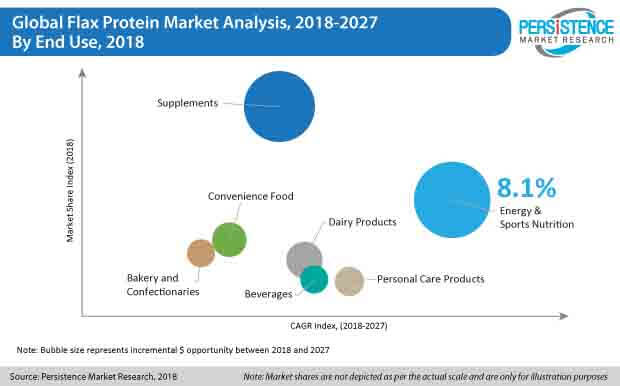Flax Protein Market Segmented By Protein Supplements, Flax Seed Protein, Plant Based Protein Supplements, Vegan Protein Powders, Flax Seed, Flaxseed Supplements
Industry: Food and Beverages
Published Date: February-2019
Format: PPT*, PDF, EXCEL
Delivery Timelines: Contact Sales
Number of Pages: 175
Report ID: PMRREP27175
According to WHO, changing lifestyles and dietary habits have contributed to the increased risk of the development of various health issues such as coronary heart disease, diabetes, and obesity among others. The role of functional food has thus become important.
There is increasing cost of healthcare, increase in life expectancy, and the desire to live a healthy life. Flax, also known as linseed, is a crop grown for fiber and seeds, and is grown in the colder regions of the world. Flaxseed is used as a source of oil, as a demulcent and emollient, and is popularly used as a dietary supplement.
Flaxseed consists of around 20-25% of proteins. Flax protein is extracted from flaxseed, and is used in the manufacturing of various food and beverage products as well as dietary and sports supplements. There is a continuous rise in the demand for flax protein as a functional food ingredient from the food and beverage, supplement, and personal care sectors.
In terms of volume, the conventional segment of flax protein shows its dominance over rest of the segments, owing to the affordable prices and as well as easy availability of conventional flax protein and products in various regions of the world. The increasing preference for organic products from developed as well as developing countries contributes to the rapid growth of the organic segment of the global flax protein market.
This can be attributed to the increased spending capacity of people, as well as rise in disposable income and the higher prices of organic flax protein.
By source, the global flax protein market can be segmented as brown flaxseed and golden flaxseed. Both, brown and golden flaxseeds are equally nutritious. However, due to easier availability, the brown flaxseed segment is expected to have a larger market share, both, in terms of value and volume.
Along with cumulating health consciousness, consumer sentiments are also oriented towards consuming food that is guilt-free in order to protect the environment. Vegan food products have gained considerable traction in the market, and hence, these consumers are opting for more plant-based products, such as flax protein.
Hence, flax protein satiate multiple consumer demands, such as vegan, and high-protein food products. In recent times, flax protein is gaining considerable traction in the market, especially in the health food products.

An increase in GDP as well as disposable, globally, both, in developed and developing countries, has resulted an increase demand for functional food products such as flax protein being viewed as a relatively affordable product. Rising awareness about the importance of protein in one’s diet has led to the popularity of protein fortification and standardization, which has proven to be one of the most influential drivers of the global flax protein market.
Protein ingredients have become an essential part of energy and sport nutrition products. Plant protein products such as flax protein are gaining popularity, and are readily included in sports nutrition products as they are perceived to be additive-free and natural. Flax protein is gaining importance in sports nutrition, since it has almost the same amino acids as in soy and dairy protein.
There are growing incidences of lifestyle-related diseases such as obesity, diabetes, and various heart-related diseases. All these conditions come as a result of the unhealthy lifestyles of consumers, and are considered curable/preventable with certain lifestyle changes and better diets.
Rising awareness regarding these facts is resulting in the increased global demand for enriched products such as flax protein. The growing preference of consumers for guilt-free products has increased the number of people opting for natural, organic, and vegan products.
Vegan products have gained considerable traction in the market. Consumers are opting for more plant-based products such as flax protein. Flax protein satiates the consumer for gluten-free, vegan, high-protein food, and hence, is high on demand. The growing demand for high protein and vegan products is driving the growth of the global flax protein market.
The growing popularity of protein blends such as dairy- and plant-based protein has also proven to be a positive factor for the growth of the global flax protein market.
Less awareness about non-soy plant proteins, such as flax protein, in several parts of the world, as well as increasing allergies due to the over-consumption of protein are some of the factors that are hindering the growth of the global flax protein market.
The global flax protein market can be regionally segmented as North America, Latin America, Europe, Asia Pacific, and the Middle East & Africa. North America, closely followed by Europe, currently has the largest market value share, owing to the high demand for fortified food products and functional food.
However, the market in APAC is expected to grow at a rapid pace, exhibiting a healthy CAGR of 8.1%. The rapid growth of flax protein market in APAC can be attributed to the growing demand for functional and fortified food products, as well as the booming sports and energy nutrition sector in prime countries such as China, India, and Japan.
The subsequent sections analyze the global flax protein market on the basis of nature, source, end use, distribution channel, and region, and presents a forecast for the period 2018–2027. The market is segmented as follows -
| Attribute | Details |
|---|---|
| by Nature |
|
| by Source |
|
| End Use |
|
| Distribution Channel |
|
| Region |
|
To know more about delivery timeline for this report Contact Sales
